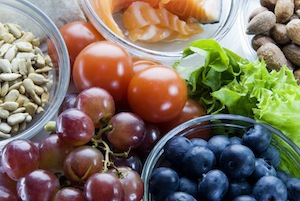 Sounds quite contradictory, right? The experts have told us for years that we as a society eat too much and in order to lose weight and/or perform better we have to cut out some of those oh-so-precious calories! We then have to wonder, how do I perform as an athlete and lose weight at the same time if I’m cutting out calories? Can I do both?
Sounds quite contradictory, right? The experts have told us for years that we as a society eat too much and in order to lose weight and/or perform better we have to cut out some of those oh-so-precious calories! We then have to wonder, how do I perform as an athlete and lose weight at the same time if I’m cutting out calories? Can I do both?
Let’s put a quick disclaimer in place first: this article is directed towards athletes, who are training regularly and are interested in losing weight for performance. Individuals who are not on an intensive training schedule and are simply after weight loss goals will have a different set of rules apply. So, if we take a step back and consider that our athlete body is in constant motion, we recognize that it’s in constant need of fuel. We can either feed it calorie dense fuels or nutrient dense fuels. Which is better?
This can be confusing, as we know that no matter how old, fast, or strong the person, we as humans still need certain nutrients to survive. So at first glance, the intake of nutrient dense fuels seems to be the better option. Then we have to consider training volume and what we expended through our exercise; perhaps then, a calorie dense diet may be the best option. Then we can really confuse things and ask, what kinds of energy are you burning during training? Outside of training? We know higher intensities require more carbohydrates. So again, the nutrient dense option doesn’t seem to work. We know that under lower intensities/stress, our bodies can burn a higher percentage of fat, so the calorie dense option doesn’t make sense if we want to shed a few pounds of fat. Ahhh! It seems that we’ve come to a crossroads.
The answer to the question is somewhere in the middle – you need both nutrient dense and calorie dense foods, but it’s all about when you eat them.
Why You Need Nutrient Dense Foods
If you look at how our body processes the calories we eat, our blood sugar plays a key role in how well we use and/or store excess calories as fat. Science tells us, and I would agree, that if you can maintain stable blood sugar levels through more nutrient dense foods, your insulin won’t be so fast to store fat. In turn, you’re creating an environment that allows your body to rely more heavily on stored fat as you aren’t constantly bombarding it with unnecessary carbohydrate.
To make this link clear, if your blood sugar is constantly having to process on-going or higher levels of starch or carbohydrate, then insulin is constantly at work directing those calories to either the muscle for storage or when spilling over, to increase fat stores. If this is constantly done, your body has little chance to burn what is stored do to the higher activity of insulin.
This is a great argument for making sure we get plenty of nutrient dense foods in. But here’s the key most people miss: even though we can be successful at eating more nutrient dense foods during the day, omitting some of the heavy starches and refined foods, and then see a decent decrease in waist circumference, we can’t sacrifice the quality of our training…which is where the calorie dense foods come in.
Why You Also Need Calorie Dense Foods
So here’s the kicker: though they may not be as “wholesome” as nutrient dense foods, eating calorie dense foods during, before and after training will actually improve performance and eventually weight loss! Why? Because our body needs energy quick in these times. If you have it available (and of course appropriate to the duration and intensity of your workout) you will achieve much higher training quality as well as speedier recovery. And of course, with the ability to train longer and harder, the weight will come off as a result. Calories need not and should not be limited during training. You wouldn’t only put half a tank of gas in your car for a 12-hour road trip would you?
After you’ve adequately fueled your training sessions, then you can re-introduce more of those nutrient dense foods to maintain an adequate “trickle” of nutrients within the bloodstream. This is the signal your body is needing and looking for: “Oh, that was a long ride, thanks for helping me recover. I’ll keep your metabolism going!” This is the thing some would refer to as the “post metabolic burn” that can be significantly affected by both your training and recovery practices. This is also what can give your body the post-workout fat-burning boost you’ve been looking for in combination with a higher nutrient dense diet. We’ll explore this more soon!
Will you lose weight with some of the other strategies such as fasted training or eating low calorie dense foods? Sure, but you could also be risking losing that lean muscle mass that allows your body to train. Increased soreness, muscle fatigue, mental exhaustion, potential sickness can all come into the picture at this point.
In short, eat calorie dense foods (and plenty of them) with high carbohydrate content before, during, and after training. For the rest of the day, eat nutrient dense foods. This timing of your meals will sustain performance and allow your body to burn off the excess fat.
Putting It Into Practice
So how exactly do you execute this nutrition strategy? Here are some key practices:
- Don’t miss breakfast, whatever you do!
- Hydrate consistently– don’t be afraid to utilize an electrolyte if training volume is daily.
- Stash some nuts/dried fruit, beef jerky in the desk drawer or your car…once you start paying attention to your blood sugar, you’ll realize how often you need them.
- Don’t train on an empty stomach – try to get in a light snack roughly 90-120 min before training. If you want to burn fat, you’ve got to have some carbs to get the fire going!
- Focus the majority of your starch/sugary carb intake in and around training so your body has a quick source of energy to maintain performance.
- Get assessed so you know what your basal metabolic rate is (outside of exercise, it’s our largest caloric expenditure) and understand how many calories you’re expending. Don’t guess!
- When you’re putting together your daily meals, aim for thirds on your plate; 1/3 protein, 1/3 healthy fat, and 1/3 vegetables, fruits, grains. This is the nutrient dense part of your day. Keep it steady and enjoy the energy that goes along with it.
When fueling for workouts, the ? rule becomes less important. Choose healthy foods, but ones with carbohydrates and calories that will digest more easily; banana, sports drinks, gels. Find something that works with your stomach!
It’ll take some practice, but over time this timing and balance can become habit. It’s all about learning to change when we eat certain foods and fueling in and around training with the calorie dense fuels our body is demanding at those times. When you learn to do this, you’ll find that you can actually eat more (in terms of calories), lose weight and attain the ultimate goal – perform at your best.
